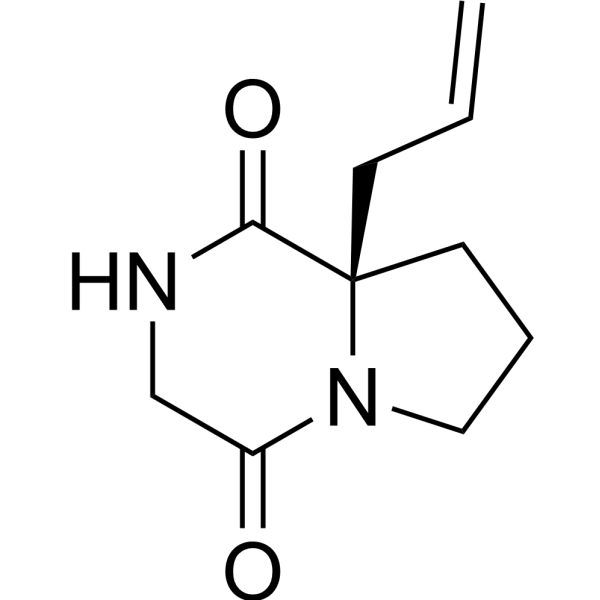NNZ 2591
Modify Date: 2025-08-28 02:01:21

NNZ 2591 structure
|
Common Name | NNZ 2591 | ||
|---|---|---|---|---|
| CAS Number | 847952-38-9 | Molecular Weight | 194.23 | |
| Density | N/A | Boiling Point | N/A | |
| Molecular Formula | C10H14N2O2 | Melting Point | N/A | |
| MSDS | N/A | Flash Point | N/A | |
Use of NNZ 2591NNZ 2591 is a synthetic analogue of a small peptide of cyclic glycine proline (cGP). NNZ 2591 shows orally active and cross the blood-brain barrier. NNZ 2591 shows neuroprotective after ischemic brain injury. NNZ 2591 improves motor function in a rat model of Parkinson's disease. NNZ 2591 has the potential for the research of ischemic brain injury[1][2]. |
| Name | NNZ 2591 |
|---|
| Description | NNZ 2591 is a synthetic analogue of a small peptide of cyclic glycine proline (cGP). NNZ 2591 shows orally active and cross the blood-brain barrier. NNZ 2591 shows neuroprotective after ischemic brain injury. NNZ 2591 improves motor function in a rat model of Parkinson's disease. NNZ 2591 has the potential for the research of ischemic brain injury[1][2]. |
|---|---|
| Related Catalog | |
| In Vivo | NNZ 2591 (30 mg/kg; p.o.) prevented scopolamine-induced memory impairment in rats[1]. NNZ 2591 (2, 20, 100 ng/rat; i.c.v.) shows neuroprotection in rats[2]. NNZ 2591 (3 mg/kg; s.c.; daily for 5 days) completely preventes brain damage and significantly reduces the L/R ratio of time taken to touch to the patch at 5 d after injury in rats[2]. Animal Model: 4 months, male young adult Wistar rats[1]. Dosage: 30 mg/kg Administration: P.o.; 10 min after the (scopolamine) i.p. administration. Result: Significantly reduced the number of M2AchR positive neurons, significantly reduced the density of synaptophysin in the CA3 and CA4 sub-regions, and altered TH terminal staining in the striatum. Animal Model: 280-310 g adult male Wistar rats[2]. Dosage: 2, 20, 100 ng/rat Administration: I.c.v.; 2 h after HI injury Result: Reduced overall tissue damage in the sub-regions of the hippocampus, DG, cerebral cortex and the striatum. Animal Model: 280-310 g adult male Wistar rats[2]. Dosage: 3 mg/kg Administration: S.c.; daily for 5 days Result: Significantly reduced the median of tissue damage scores in the CA1-2, CA3 and CA4 sub-regions of the hippocampus, the DG. |
| Molecular Formula | C10H14N2O2 |
|---|---|
| Molecular Weight | 194.23 |
| InChIKey | WVKCGUOWPZAROG-JTQLQIEISA-N |
| SMILES | C=CCC12CCCN1C(=O)CNC2=O |